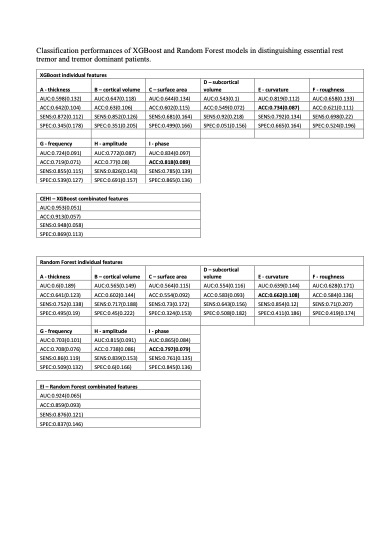Category: Parkinson's Disease: Neuroimaging
Objective: This study aimed to differentiate between essential tremor with rest tremor (rET) and tremor-dominant Parkinson’s disease (td-PD) patients through a machine learning (ML) approach based on RT electrophysiological features and structural MRI data.
Background: The differential diagnosis between td-PD and rET may be challenging, and often requires expensive procedures such as dopamine imaging, not widely available in clinical practice. Ancillary tests with larger availability such as rest tremor (RT) electrophysiological analysis and brain MRI, may help in distinguishing between these two diseases.
Method: We enrolled 42 td-PD patients and 32 rET patients in the study. All patients underwent RT analysis using surface electromyography and brain 3T MRI. Simple electrophysiological features (frequency, amplitude, phase) of rest tremor were calculated on RT recordings. Several MR morphometric variables (thickness, surface area, cortical volume, roughness, mean curvature) of brain cortical regions were extracted using Freesurfer on T1-weighted images. Two classification models (XGBoost and Random Forest, RF) using MRI and electrophysiological data were tested in distinguishing between td-PD and rET patients.
Results: ML models based either on MRI data or RT electrophysiological data, separately reached suboptimal or barely acceptable accuracy in distinguishing td-PD from rET patients (accuracy of the best model: 73% and 82%, respectively). Conversely, the combination of RT electrophysiological and brain MRI data enabled several RF and XGBoost models to reach very high classification performances. The best model was based on XGBoost using a combination of RT phase, RT amplitude, surface area and mean curvature cortical metrics, with the RT phase as the feature with the highest importance score, and reached accuracy of 0.913 ±0.057, sensibility of 0.948 ±0.058 and Specificity of 0.869 ±0.113 in cross-validation analysis in distinguishing between td-PD and rET patients.
Conclusion: A Machine learning approach combining electrophysiological and MRI data showed great potential in distinguishing between td-PD and rET patients and could represent a valid tool to help clinicians in the differential diagnosis of rest tremor syndromes in the absence of high-cost technologies such as dopamine imaging.
To cite this abstract in AMA style:
F. Aracri, M. Bianco, C. Calomino, M. de Maria, B. Vescio, J. Buonocore, A. Sarica, A. Quattrone. Structural MRI and tremor analysis in the differential diagnosis of rest tremor [abstract]. Mov Disord. 2023; 38 (suppl 1). https://www.mdsabstracts.org/abstract/structural-mri-and-tremor-analysis-in-the-differential-diagnosis-of-rest-tremor/. Accessed April 1, 2025.« Back to 2023 International Congress
MDS Abstracts - https://www.mdsabstracts.org/abstract/structural-mri-and-tremor-analysis-in-the-differential-diagnosis-of-rest-tremor/

